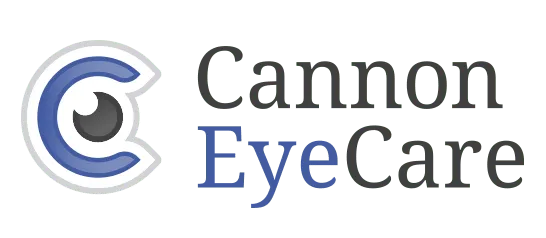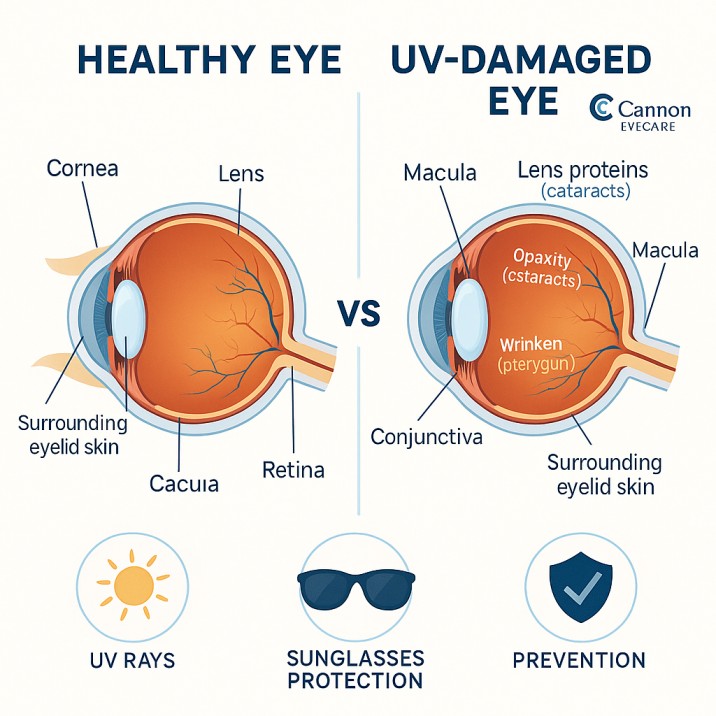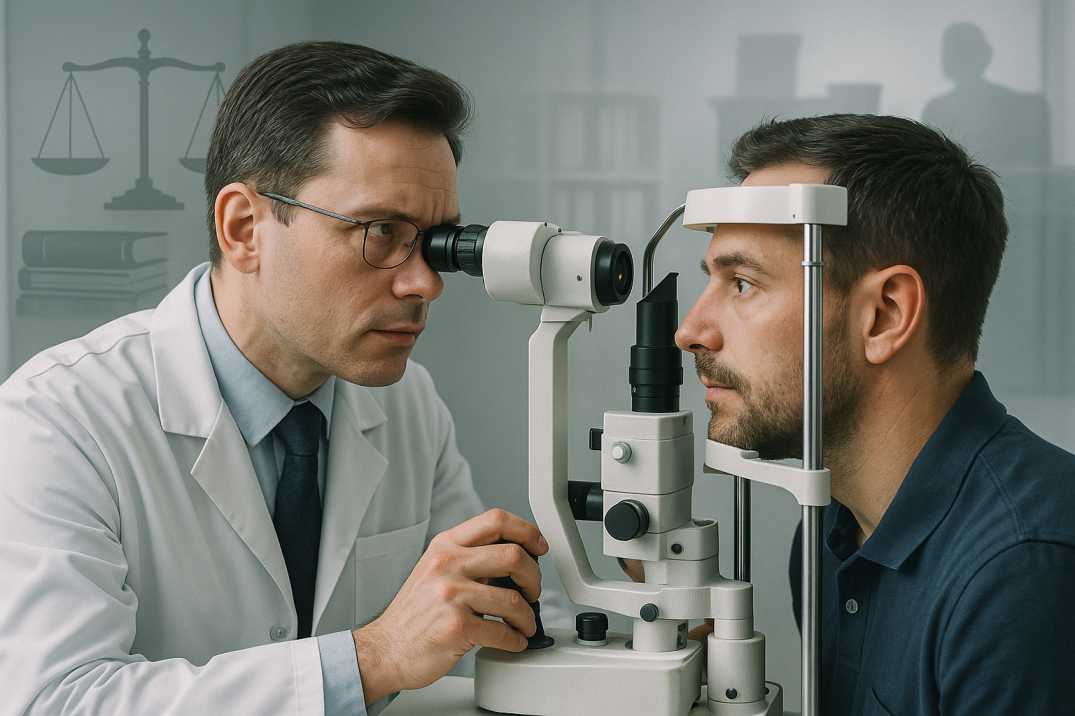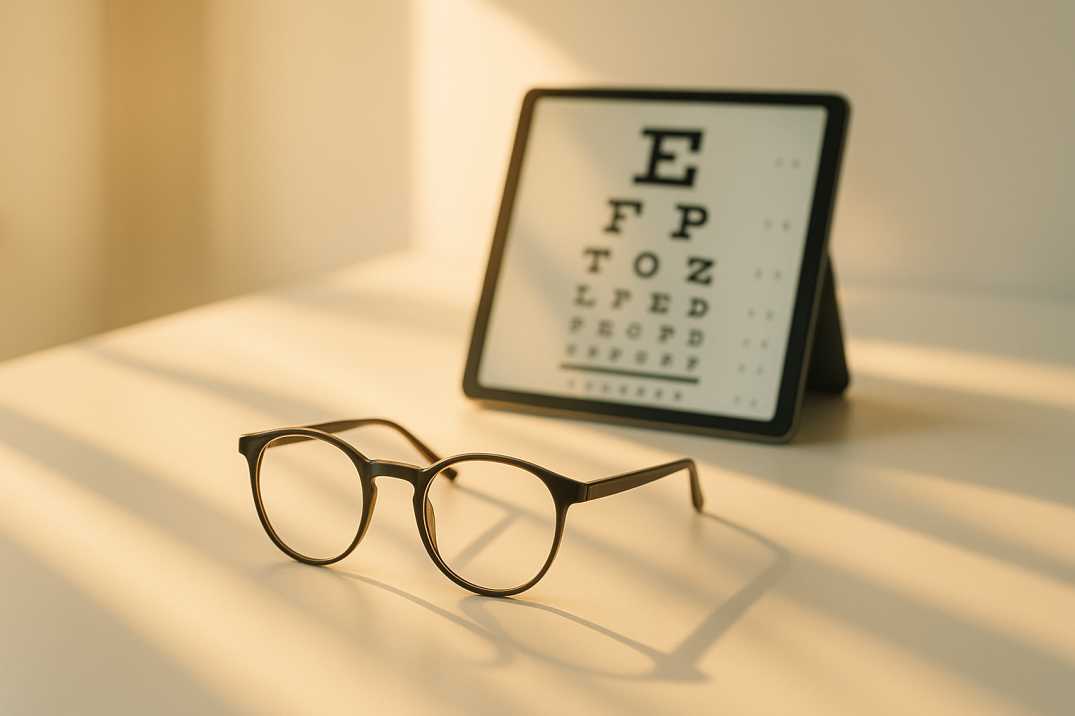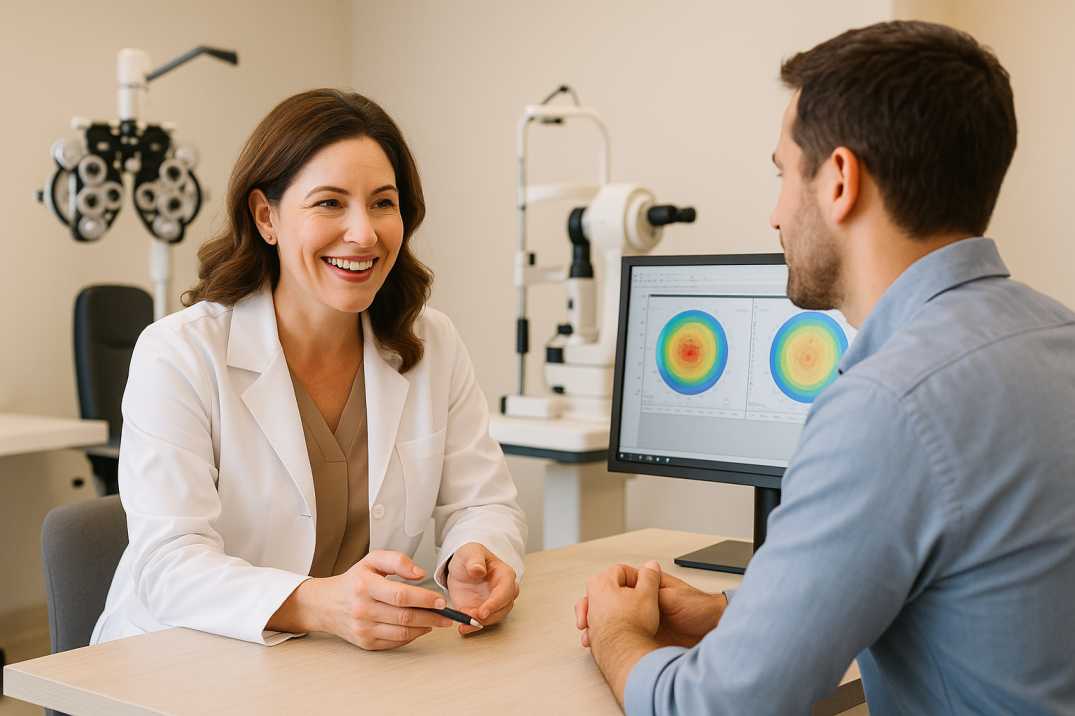Summer Eye Protection: UV Safety Tips from Seattle Experts
Bottom Line Up Front: Your eyes need sunscreen, too. Professional-grade UV protection through quality sunglasses, wide-brimmed hats, and smart outdoor habits can prevent 20% of cataracts and significantly reduce your risk of vision-threatening conditions like macular degeneration and pterygium—even in the cloudy Pacific Northwest.
Seattle’s summer sun brings longer days, outdoor adventures, and increased UV exposure that many Pacific Northwest residents underestimate. While you’re diligent about protecting your skin with sunscreen, your eyes need equally careful attention. At Cannon EyeCare, we’ve witnessed how cumulative UV damage affects Seattle professionals who thought cloudy skies provided adequate protection—they don’t.
Whether you’re hiking Mount Rainier, sailing Puget Sound, or simply commuting through University Village, understanding the UV protection Seattle residents need can preserve your vision for decades to come. This comprehensive summer eye safety guide shares evidence-based strategies from Seattle eye care experts to keep your eyes healthy all season long.
Understanding UV Radiation: The Silent Threat to Your Vision
Ultraviolet radiation consists of three types: UVA, UVB, and UVC. While Earth’s ozone layer blocks UVC rays, UVA and UVB radiation reach us daily, creating cumulative damage to delicate eye structures.
UVA rays (320-400 nanometers):
- Penetrate deeper into eye tissues
- Reach the lens and retina
- Linked to cataracts and macular degeneration
- Present year-round, even through clouds
UVB rays (280-320 nanometers):
- Primarily affects surface structures
- Causes photokeratitis (corneal sunburn)
- Contribute to pterygium development
- Strongest during summer months
The Pacific Northwest UV Reality
Many Seattle residents mistakenly believe persistent cloud cover protects them from UV damage. Research shows overcast days still deliver 80% of UV radiation, while reflective surfaces like Puget Sound’s water can increase exposure by up to 100%.
High-altitude activities popular among Seattleites—skiing at Crystal Mountain or hiking in the Cascades—pose additional risks. UV intensity increases 10-12% per 1,000 meters of elevation, making mountain protection crucial for active Pacific Northwest residents.
The Science Behind UV Eye Damage: Recent Research Findings
Study 1: Lifetime UV Exposure and Cataract Risk (2025 Data)
Current global health estimates confirm that at least 20% of cataracts worldwide are directly attributable to excess UV exposure. With approximately 4 million cataract surgeries performed annually in the United States and over 24 million Americans affected by cataracts, UV protection represents a critical preventive measure. Research consistently shows that individuals with lifelong UV protection experience delayed cataract onset and better long-term vision outcomes.
Study 2: Age-Related Macular Degeneration Statistics (2025)
Recent CDC data reveals that nearly 20 million Americans aged 40 and older are living with some form of age-related macular degeneration, with 1.49 million experiencing vision-threatening late-stage AMD. While age and genetics remain primary risk factors, UV exposure contributes to retinal oxidative stress that may accelerate disease progression, making consistent protection essential for long-term retinal health.
Study 3: Children’s UV Vulnerability Research (2024-2025)
Current research demonstrates that children can receive approximately three times more annual UV exposure than adults due to:
- Larger pupils allow more light penetration
- Clearer ocular lenses with less natural filtering (up to 70% more light transmission than adults)
- Extended outdoor activity time
- Inconsistent protective eyewear use
This research underscores why establishing sun protection habits early prevents cumulative damage that manifests in later decades.
Essential Summer Eye Safety and Protection Strategies
1. Quality Sunglasses: Your First Line of Defense
What to Look For:
- UV400 protection or “100% UV protection” labeling
- Wraparound or close-fitting styles to prevent peripheral UV entry
- Polarized lenses for glare reduction from water and reflective surfaces
- Impact-resistant materials (polycarbonate or Trivex) for active lifestyles
Seattle-Specific Considerations: Professional Seattle eye care providers recommend wraparound styles for marine activities and polarized lenses for driving during low-sun angles common in our region. Whether you’re commuting to Pike Place Market or weekend sailing, proper sunglasses eye protection remains non-negotiable for summer eye safety.
Price vs. Protection Reality: Expensive doesn’t always mean better protection. Quality UV-protecting sunglasses are available across all price ranges—from under $20 gas station pairs with UV400 certification to premium $300+ designer frames. Research from 2025 shows that effective UV protection depends on proper certification (UV400 or 100% UVA/UVB protection), not price point. Always verify protection standards rather than relying on cost or lens darkness.
2. Wide-Brimmed Hats: Complementary Protection
A quality wide-brimmed hat (minimum 4-inch brim) blocks up to 50% of UV rays reaching your eyes and provides crucial protection for the delicate eyelid skin. Seattle professionals can easily incorporate stylish sun hats into their outdoor wardrobe while maintaining the sophisticated aesthetic our city values.
3. Smart Timing and Environmental Awareness
Peak UV Hours to Avoid: Summer UV intensity peaks between 10 AM and 4 PM. When possible, schedule outdoor activities during early morning or evening hours. Seattle’s northern latitude provides some natural protection, but summer months still require vigilance during peak hours.
Reflective Surface Awareness:
- Water reflection: Puget Sound, Lake Washington, and other water bodies can double UV exposure
- Sand and concrete: Beach trips and urban environments increase reflected radiation
- Snow: Winter and spring mountain activities present extreme reflection risks (up to 80%)
4. Contact Lens Users: Special Considerations
If you wear contact lenses, choose UV-blocking varieties when available. However, remember that contact lenses only protect the area they cover—you still need sunglasses for comprehensive protection of your eyelids, conjunctiva, and surrounding skin.
For Seattle’s active lifestyle enthusiasts who find sunglasses impractical during certain sports, UV-blocking contacts provide partial protection but should never replace proper eyewear when possible.
Age-Specific Protection Guidelines
Children and Teenagers (Ages 5-17)
Young eyes are particularly vulnerable to UV damage due to larger pupils and clearer lenses that allow more harmful radiation to reach the retina. Studies show children can accumulate triple the annual UV exposure of adults, making early protection habits crucial.
Recommendations:
- Start sunglass habits as early as age 2
- Choose unbreakable, comfortable frames designed for active play
- Look for fun designs that encourage consistent wear
- Educate children about eye protection importance
Young Professionals (Ages 25-40)
Seattle’s tech professionals and healthcare workers often underestimate their UV exposure during commuting and lunch breaks. Cumulative damage during these peak working years significantly impacts long-term eye health.
Key Strategies:
- Keep prescription sunglasses in your car or office
- Invest in photochromic (transition) lenses for convenience
- Consider UV-protective clear lenses for regular glasses
- Maintain consistent protection during weekend outdoor activities
Mature Adults (Ages 45+)
As natural UV filtering decreases with age, protection becomes even more critical. By age 65, eyes lose approximately 50% of their natural UV protection, making external barriers essential.
Enhanced Protection Measures:
- Regular comprehensive eye exams to monitor UV-related changes
- Consider wraparound styles for maximum coverage
- Be extra vigilant about protecting yourself during cataract recovery
- Discuss the family history of macular degeneration with your eye care provider
Seattle-Specific UV Challenges and Solutions
Marine Environment Protection
Puget Sound’s reflective water surface creates unique challenges for Seattle boaters, ferry commuters, and waterfront workers. Water can reflect up to 25% of UV radiation, effectively doubling your exposure.
Marine-Specific Tips:
- Choose polarized, wraparound sunglasses for sailing and boating
- Consider UV-protective clothing for extended water exposure
- Use broad-spectrum sunscreen around the eyes (mineral-based to prevent stinging)
- Keep backup sunglasses on boats and near water activities
Mountain and Alpine Activities
Washington’s stunning Cascade Range offers year-round UV challenges. At mountain elevations, UV intensity increases 10-12% per 1,000 meters, and snow reflection can create extreme exposure conditions.
Alpine Protection Strategies:
- Invest in glacier glasses for high-altitude activities
- Layer protection with goggles plus wraparound sunglasses
- Consider photochromic lenses that darken with UV exposure
- Never assume cloudy mountain weather eliminates UV risk
Urban Reflection Hazards
Seattle’s glass buildings, concrete surfaces, and metal structures create unexpected UV reflection zones downtown and in neighborhoods like South Lake Union and Belltown.
Urban Protection Tips:
- Maintain sunglasses during short outdoor trips
- Be aware of the reflection from building facades
- Consider UV protection during covered outdoor dining (patios under umbrellas)
- Protect your eyes during events at outdoor venues like Pike Place Market
Recognizing and Preventing UV-Related Eye Conditions
Photokeratitis: Acute UV Damage
Often called “snow blindness,” photokeratitis is essentially a corneal sunburn that can occur within hours of intense UV exposure.
Symptoms:
- Severe eye pain and redness
- Feeling of “sand” in the eyes
- Tearing and light sensitivity
- Temporary vision blurriness
Prevention: Consistent UV protection, especially during high-reflection activities like skiing, water sports, or beach visits.
Pterygium: “Surfer’s Eye” in the Pacific Northwest
Despite Seattle’s reputation for rain, we regularly treat pterygium cases at Cannon EyeCare. This fleshy growth on the eye’s white surface results from chronic UV exposure and can distort vision if left untreated.
Early Warning Signs:
- Yellowish bump on the white of the eye
- Chronic irritation or redness
- Vision changes or astigmatism shifts
- Persistent dry eye symptoms
Seattle Prevention: Year-round UV protection Seattle experts recommend is especially important for outdoor workers, marine enthusiasts, and mountain sports participants who face increased summer eye safety risks.
Cataracts: Accelerated by UV Exposure
While cataracts commonly develop with age, UV exposure can trigger the need for surgery decades earlier than natural aging would dictate.
UV’s Role in Cataract Development:
- Damages proteins in the eye’s natural lens
- Accelerates clouding and vision impairment
- Current data shows cataracts affect over 24 million Americans
- Nearly half of Americans will experience cataracts by age 80
- Creates cumulative damage over lifetime exposure
Protection Impact: Research demonstrates that consistent UV protection throughout life can significantly delay cataract onset and reduce the risk of other UV-related eye conditions. Quality UV-blocking sunglasses that filter 99-100% of UV rays can reduce ocular UV exposure by up to 99%, providing substantial protection against vision-threatening conditions.
Age-Related Macular Degeneration: A Preventable Component
While genetics and age are primary AMD risk factors, UV exposure contributes to retinal oxidative stress that may accelerate disease progression.
Controllable Risk Factors:
- Smoking (doubles AMD risk)
- UV exposure (daily protection recommended)
- Nutrition (antioxidant-rich diet supports eye health)
Professional Recommendations from Seattle Eye Care Experts
At Cannon EyeCare, we’ve observed how consistent UV protection Seattle residents maintain dramatically impacts our patients’ long-term eye health. Here are our evidence-based summer eye safety recommendations for Seattle residents:
Daily Habits for Optimal Protection
Morning Routine:
- Apply UV-protective lip balm and eye cream
- Grab sunglasses before leaving home (even on cloudy days)
- Keep backup sunglasses in your car, office, and gym bag
Midday Awareness:
- Take the “shadow test”—if your shadow is shorter than you are, UV intensity is high
- Seek shade during peak hours (10 AM-4 PM)
- Wear sunglasses for any outdoor activity longer than 15 minutes
Evening Care:
- Remove makeup gently to avoid irritating UV-exposed skin
- Use cooling eye compresses if you’ve experienced bright sun exposure
- Apply moisturizer with antioxidants around the eye area
Choosing the Right Eye Care Provider
When selecting an optometrist in Seattle, look for providers who:
- Emphasize preventive UV protection education
- Offer comprehensive retinal photography to monitor changes
- Carry quality sunglass frames with proper UV certification
- Understand Pacific Northwest-specific UV challenges
- Provide prescription sunglass options for vision correction needs
Nutritional Support for UV-Exposed Eyes
While external protection remains paramount, certain nutrients can support your eyes’ natural defense against UV damage:
Key Eye-Healthy Nutrients:
- Lutein and Zeaxanthin: Found in leafy greens, act as natural sunglasses for the retina
- Vitamin C: Antioxidant protection found in citrus fruits and berries
- Vitamin E: Supports cellular protection, found in nuts and seeds
- Omega-3 fatty acids: Anti-inflammatory support from fish and flax seeds
- Zinc: Essential mineral found in oysters, beef, and pumpkin seeds
Seattle-Friendly Sources: Take advantage of our region’s incredible farmers markets and fresh seafood for eye-healthy nutrition. Pike Place Market vendors offer excellent lutein-rich greens, while our Pacific Northwest salmon provides omega-3s that support overall eye health.
Creating a Summer Eye Safety Protection Plan
Step 1: Assess Your Personal Risk Factors
Consider your UV exposure risk:
- Outdoor occupation or hobbies
- Family history of eye disease
- Previous eye surgeries or conditions
- Medications that increase photosensitivity
- Light-colored eyes (higher UV sensitivity)
Step 2: Invest in Quality Protection
Essential Gear Checklist:
- Primary sunglasses with UV400 protection
- Backup pair for car/office
- Wide-brimmed hat for extended outdoor time
- Prescription sunglasses if you wear corrective lenses
- UV-protective contact lenses (if applicable)
Step 3: Establish Consistent Habits
Daily Practices:
- Check UV index forecasts (available on weather apps)
- Apply sunglasses before stepping outside
- Reapply sunscreen around the eyes every 2 hours during extended exposure
- Take breaks in shade during peak UV hours
- Stay hydrated to support overall eye health
Step 4: Schedule Regular Eye Exams
Monitoring Timeline:
- Ages 20-39: Every 2-3 years, or as recommended
- Ages 40-64: Every 1-2 years
- Ages 65+: Annually
- High-risk individuals: As directed by your eye care provider
Technology and Innovation in UV Protection
Photochromic Lens Advances
Modern photochromic (transition) lenses offer significant improvements over older technology:
- Faster transition times in and out of sunlight
- Enhanced UV blocking even in the clear state
- Temperature independence for consistent performance
- Blue light filtering for digital device protection
Smart Sunglass Features
Emerging technology in protective eyewear includes:
- UV sensors that alert users to high exposure
- Prescription compatibility with advanced lens materials
- Anti-fog coatings for active lifestyles
- Customizable tinting based on activity needs
Emergency UV Exposure: What to Do
If you experience acute UV eye exposure without protection:
Immediate Steps:
- Get indoors or seek shade immediately
- Remove contact lenses if wearing them
- Apply cool, clean compresses to closed eyes
- Use preservative-free artificial tears for comfort
- Avoid rubbing your eyes
When to Seek Professional Care:
- Severe eye pain lasting more than 2 hours
- Vision changes or persistent blurriness
- Discharge or signs of infection
- Light sensitivity that doesn’t improve with rest
- Any concern about potential eye damage
Contact Cannon EyeCare or your trusted Seattle eye care provider for urgent evaluation if symptoms persist or worsen.
Additional Resources for Eye Health and UV Protection
For readers seeking additional information about eye health, UV protection, and vision care, these authoritative resources provide valuable insights from leading medical organizations:
American Academy of Ophthalmology – UV Protection Guide
Comprehensive information about ultraviolet radiation effects on eyes, including detailed prevention strategies and risk factors from the nation’s leading eye care organization.
CDC Vision Health Surveillance System – AMD Data
Official government statistics on age-related macular degeneration prevalence, including state-by-state data and demographic breakdowns for evidence-based health planning.
National Eye Institute – UV Radiation and Your Eyes
Scientific research findings on how UV exposure affects eye health, featuring the latest studies on cataracts, macular degeneration, and protective measures.
BrightFocus Foundation – Macular Degeneration Facts
Current statistics and research updates on macular degeneration, including risk factors, prevention strategies, and breakthrough treatment developments.
These resources complement the personalized care and expertise available at Cannon EyeCare. For Seattle-specific recommendations and comprehensive eye examinations, schedule your appointment with our experienced optometry team.
The Long-Term Vision: Protecting Your Future Sight
Consistent UV protection today directly impacts your vision quality decades from now. Research consistently shows that individuals who maintain daily UV protection throughout their lives experience:
- Delayed onset of cataracts by an average of 8-12 years
- Reduced risk of pterygium requiring surgical intervention
- Lower rates of eyelid skin cancer in the delicate periocular area
- Better preservation of central vision as they age
For Seattle professionals balancing busy careers with active Pacific Northwest lifestyles, incorporating UV protection into daily routines represents a small investment with profound long-term returns.
Conclusion: Your Vision Deserves Professional Protection
Summer sun protection for your eyes isn’t optional—it’s essential healthcare. Whether you’re a tech professional commuting through South Lake Union, a healthcare worker walking between hospitals, or an outdoor enthusiast exploring Washington’s incredible landscapes, your eyes face daily UV exposure that accumulates over time.
The evidence is clear: quality sunglasses eye protection and comprehensive summer eye safety measures today prevent vision-threatening conditions tomorrow. From choosing proper UV protection Seattle residents need to understanding our region’s unique UV challenges, small daily habits create lasting vision benefits.
At Cannon EyeCare, we’re committed to helping Seattle residents maintain healthy vision through every season. Our comprehensive approach combines advanced diagnostic technology with personalized prevention strategies that fit your lifestyle and protect your long-term eye health.
Ready to protect your vision? Schedule a comprehensive eye examination at Cannon EyeCare to discuss your UV protection strategy. Our experienced optometrists will evaluate your risk factors, recommend appropriate protective eyewear, and ensure your eyes remain healthy for years to come.
Don’t let UV damage steal your sight—invest in professional eye protection today. Your future vision depends on the choices you make this summer.
Contact Cannon EyeCare today to schedule your comprehensive eye examination and UV protection consultation.
FAQs
-
Choose sunglasses labeled “UV400” or “100% UVA/UVB protection.” Wraparound styles provide extra coverage by blocking sunlight from the sides
